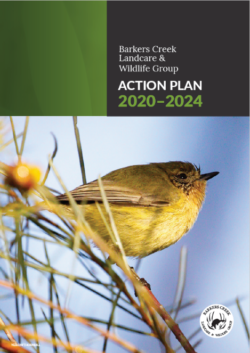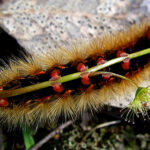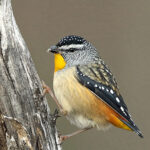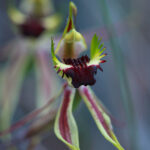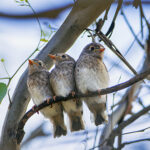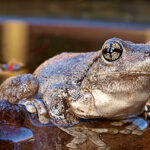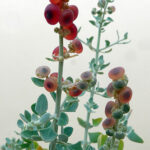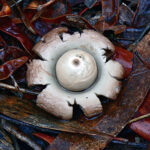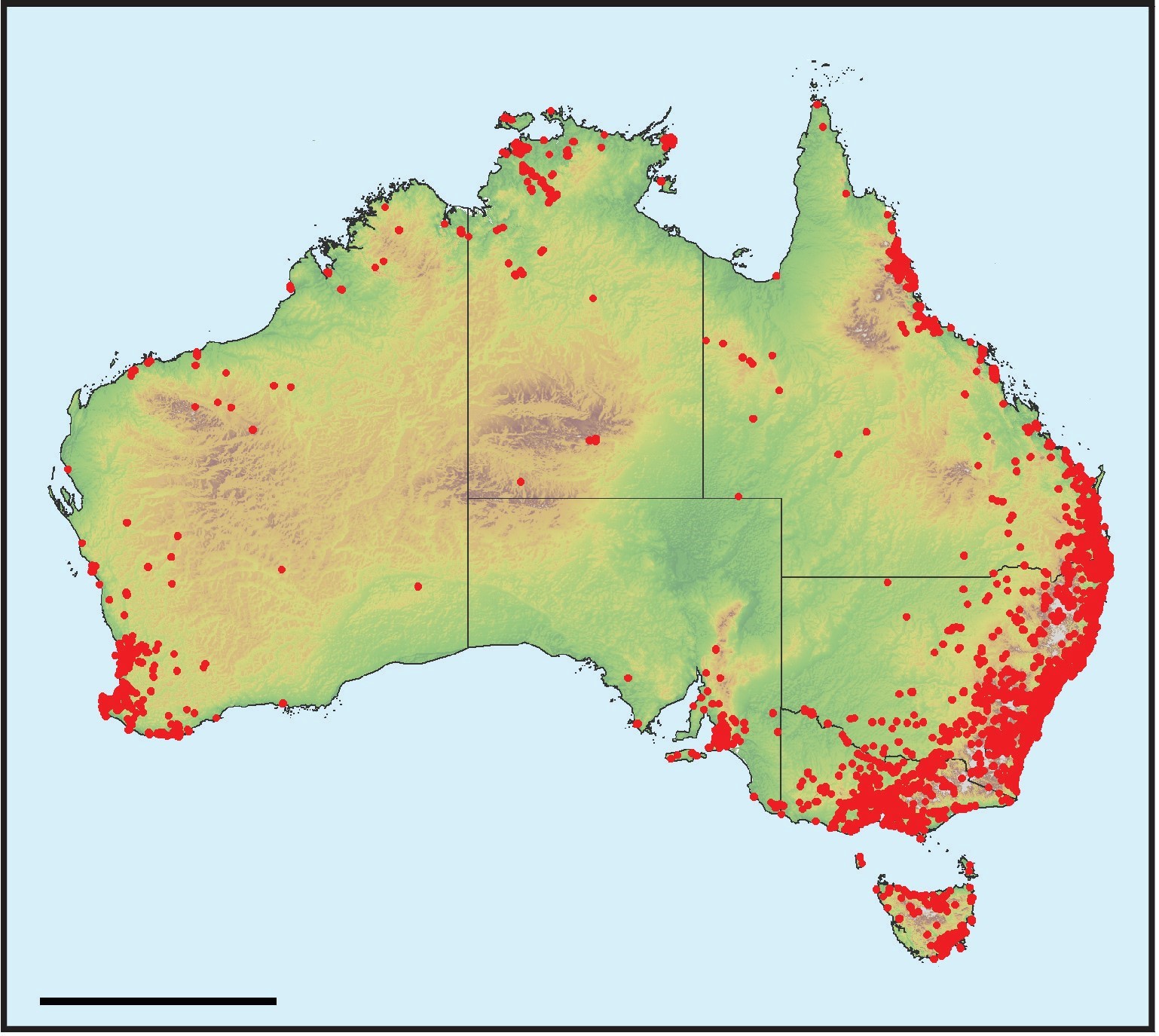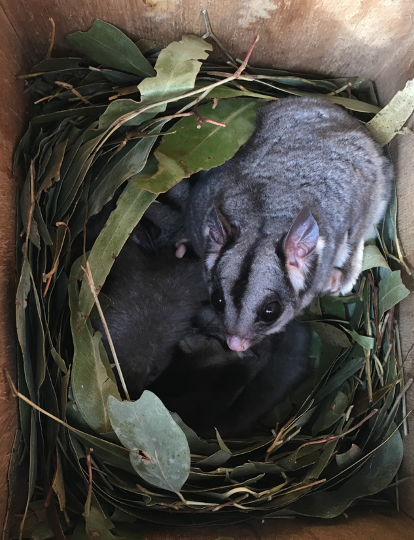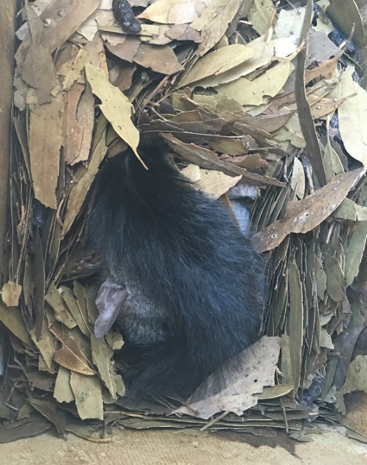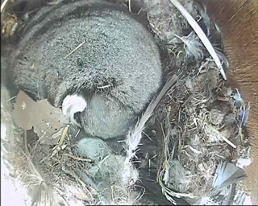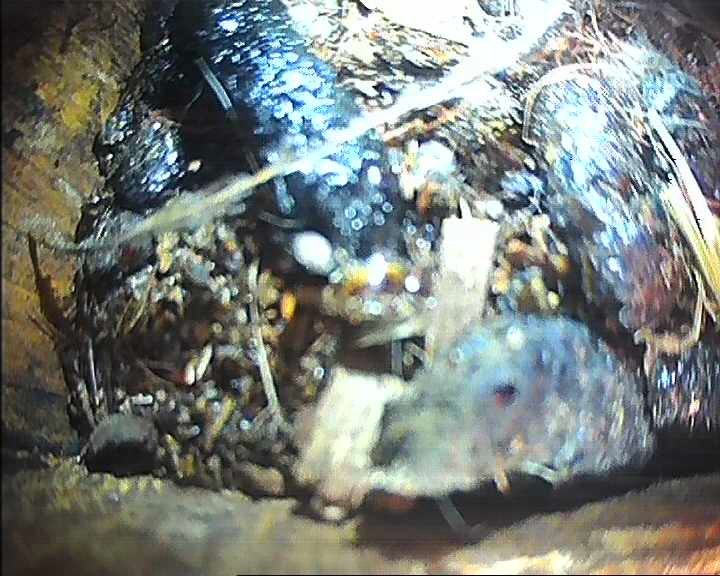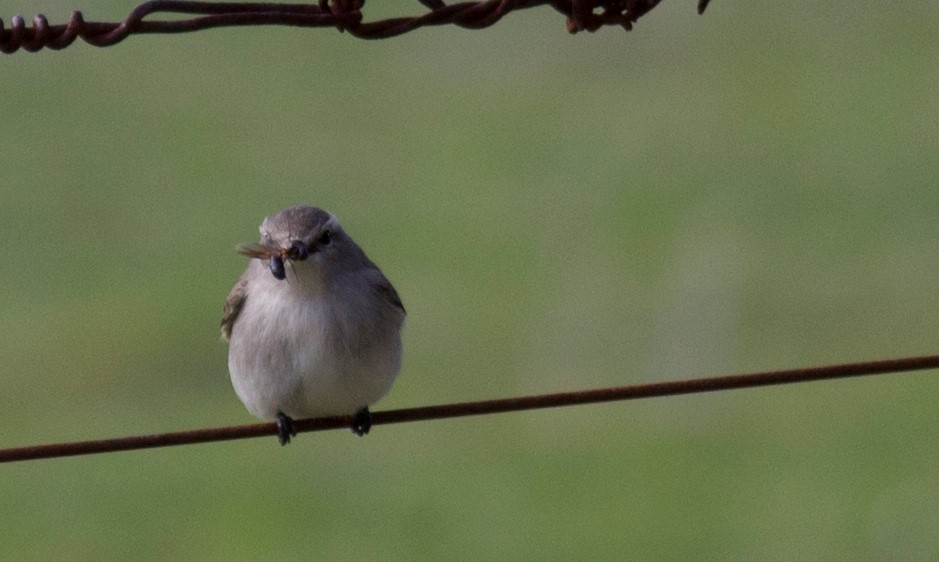Beginner birdwatching with Inala Foundation
Posted on 13 August, 2020 by Jess
The Inala Foundation, a habitat conservation organisation based in Bruny Island, Tasmania, is running a free online event titled a ‘Beginner’s Guide to Birdwatching’. We think this is a fantastic theme for an event, as we know there’s a strong interest in bird watching in our local Mount Alexander region. Interestingly, we’ve recently been planning our own ‘Birding for beginners’ event for later in 2020, but want to share this in case it’s of interest to the community in the meantime. Please see the details below from the Inala Foundation, including how to register.

The Swift Parrot enjoys habitat in Bruny Island, Tasmania, as well here in the Mount Alexander region of central Victoria (Photo: Michael Gooch)
Birdwatching is a great activity that everyone can enjoy. During the COVID-19 lockdown period we have seen a huge increase in the number of new birdwatchers around the world. Many people are navigating their way through the maze that is birdwatching optics and scratching their heads about learning to ID birds, particularly how to differentiate some of the trickier species.
The Inala beginners guide to birdwatching answers all these questions and more. Join us online on Saturday 22 August 2020 for a free introduction and live question/answer session.
When: Saturday 22 August 2020, 10:00 am – 11:00 am
Cost: Free
To register and find more information: click here
‘Impact of urbanisation on birds’ with Jacinta Humphrey – Connecting Country AGM 2020
Posted on 6 August, 2020 by Ivan
Connecting Country would like to warmly (and safely) invite you to the Connecting Country 2020 Annual General Meeting (AGM) on Saturday 26 September 2020 at 2.00 pm.
This year’s AGM will be a little different: for the first time ever we are planning an online event. But as usual Connecting Country style, it will be much more than an AGM and will feature two very special presentations. This year’s AGM theme is resilience and adapting to change, and we have signed up two guest speakers who have been involved in monitoring ecological change over time. Long-term ecological monitoring is vital if we are to have accurate data to make informed decisions about land management, and develop strategies to address the ongoing decline and extinction of our wildlife.
We’re delighted to present our two excellent and engaging AGM guest speakers:
Jess Lawton (Connecting Country) on ‘Connecting Country’s ten years of ecological monitoring‘. Jess is our treasured Monitoring Coordinator, PhD candidate and resident phascogale expert. Join Jess on a journey through Connecting Country’s long-term monitoring programs, with a focus on nest boxes and bird surveys.
 Jacinta Humphrey (La Trobe University) on ‘The impact of urbanisation on birds’. Jacinta is a PhD student at La Trobe University and member of the Research Centre for Future Landscapes. Join Jacinta to hear about her research into the impact of expanding urbanisation on wildlife, with a focus on birds – a key issue raised by the local community during our recent Habitat Health Check project. To view Jacinta’s engaging video summarising her project – click here
Jacinta Humphrey (La Trobe University) on ‘The impact of urbanisation on birds’. Jacinta is a PhD student at La Trobe University and member of the Research Centre for Future Landscapes. Join Jacinta to hear about her research into the impact of expanding urbanisation on wildlife, with a focus on birds – a key issue raised by the local community during our recent Habitat Health Check project. To view Jacinta’s engaging video summarising her project – click here
The AGM 2020 will also include a brief presentation from staff and committee members about Connecting Country’s achievements over the last decade, to allow supporters old and new to hear what Connecting Country does and our plans for the coming year. This is a free online, which is open to all members of Connecting Country and our community from near and far.
Booking is essential for this event. To register for the AGM and receive the online link to attend please – click here
There will be no super-delicious catering at this year’s AGM, but feel free to join us for some online discussion and chit-chat after the event, maybe even a BYO refreshment! If you have any questions, please email ivan@connectingcountry.org.au or call (03) 5472 1594.
AGM formalities:
- Click here to download the agenda
- Click here to download a committee nomination form
- Click here to download the proxy voting form
- Click here to complete a membership application
- Click here to download the 2019 AGM minutes

The Connecting Country team at Camp out on the Mount 2019, minus Ivan Carter (photo by Heather Barrett)
Loss of Maldon Urban Landcare Group’s valuable restoration work
Posted on 6 August, 2020 by Frances
Unfortunately a large area of established revegetation of local native plants was cleared this week in Maldon.
The revegetation site is located on the northern end of the former South German Mine in Phoenix Street, Maldon VIC. Maldon Urban Landcare Group (MULGA) successfully revegetated the site as part of a larger long-term restoration project to restore the site that began in the 1990s.
An article about the revegetation site and the project was published in the 2015 Victorian Landcare and Catchment Magazine. To view the article – click here
The northern end of the site has now been groomed and almost entirely cleared of vegetation. We understand the area was cleared by an operator under the direction of Parks Victoria, who are responsible for managing the land. MULGA were not informed or consulted about this action.
Naturally, MULGA members have expressed their distress, frustration and disappointment that this has happened. Local Parks Victoria staff are in contact with MULGA regarding their concerns.
MULGA is one of Victoria’s oldest Landcare Groups. They are well respected and known as a hardworking, dedicated group of volunteers who put a huge effort into restoring the degraded reserves around Maldon. To learn more about MULGA’s work – click here
Barkers Creek Landcare & Wildlife Group take action during COVID-19
Posted on 6 August, 2020 by Jacqui
Action Plan from Barkers Creek Landcare & Wildlife Group
Barkers Creek Landcare & Wildlife Group recently released their impressive action plan for 2020-2024.
COVID-19 safety restrictions meant the group couldn’t hold a workshop and meet in person as planned. Instead they held an online member survey to get feedback on priorities for the next five years, and find out what members enjoy most about being in the group.
I’m sure you’ll agree the result is a beautifully presented and informative plan, complete with a map of their project sites and new signs, and lovely photos of plants and animals, and working bees in Barkers Creek!
To view the plan – click here
From the plan:
‘Once again, the survey really affirms how much people love living in Barkers Creek and how committed they are to restoring our local environment whether that be on public land or private property.
We encourage people to explore our group’s Landcare website – www.barkerscreeklandcare.org.au and join our group… and let’s see what we can achieve in the next 5 years.’
‘…Barkers Creek is a ‘Community’ … it’s not just the bit of ground between Harcourt and Castlemaine where it has been dug up, chopped down or dumped on.’
All the plant and animal photos were taken in Barkers Creek!
Revisited: dam that is good habitat
Posted on 30 July, 2020 by Ivan
The rain has been steady across autumn and winter this season and it has been a pleasure seeing the many farm dams across our region mostly full to the brim and overflowing. The farm dam can be simply that, a farm dam for stock and irrigation, or it can be a farm dam along with important ecological values and habitat potential. There are plenty of small actions that landowners can implement to improve the habitat value of their dam. Dams can provide vital resources and habitat for fauna during heatwaves and extended drought periods, and can be important links in ecological restoration across the landscape.
One of Connecting Country’s most popular posts over the past five years was about turning your dam into habitat. It was our highest-ranking post in terms of the number of views, and highlighted some practical actions landholders could take to improve their dams. In light of the recent interest in this topic we decided to republish the blog post here, along with some new links to useful resources on the topic
We thank Damien Cook for his slide presentation from the workshop, which is available via the link at the bottom of this post.
Turning your Dam into Habitat
Wetland ecologist, Damien Cook presented the ‘Turning Your Dam into Habitat’ workshop in April 2017 on his property in Spring Gully. Participants heard about the possibilities and practical steps for turning farm dams into habitat, wetland ecology and managing soil erosion in ephemeral creek lines.
Damien started the day talking about a swale that he and partner Elaine Bayes had built to divert water away from the house. This swale helps prevent water gushing in their front door and provides habitat for animals by remaining moist when nearby areas have dried out in times of less rain. We also heard how it acts as a biofilter and helps with mitigating soil runoff in times of high rain.
Next we moved to a small frog pond near the house. This pond had previously been the site of a driveway but had been renovated to encourage frogs and provide space for wetland plants. Here Damien talked about encouraging insects as prey for frogs and fish and about nutrient cycling that occurs with wet and drying conditions. Plant species in this pond include Swamp Wallaby Grass (Amphibromus fluitans), Common Swamp Wallaby-grass (Amphibromus nervosus), Ridged Water-milfoil (Myriophyllum porcatum) and Water Ribbon (Cycnogeton procerum). Damien recounted hearing five different species of frog using this small pond. When asked if he had introduced the frogs, he responded that “no, I invited them by providing conditions that frogs liked”.
A short walk through the paddock included a quick stop to listen for and talk about the Biberon’s Brooding Frog, (Pseudophryne bibroni) whose unusual parenting habits include the stay at home dads looking after the fertilised eggs until rain comes and disperses his brood. Damien also pointed out that his paddock was home the Golden Sun Moth, another critically endangered species.
At the first of three dams on the property Damien explained that, as with most dams, it was constructed in a way that has ensured it’s surface was largely subsoil. Damien had therefore built up the banks with introduced top soil and planted Jointed Twig Rush (Baumea articulata) into them. He had also planted Old Man’s Weed (Centipeda cunninghamii) and Eel Grass (Vallisneria australis), the later being a delicious treat for the resident yabbie population. This dam provided an opportunity to talk about why it’s good not to have trees on dam walls, creating floating pontoons in deep dams, and making shallow areas and peninsulas if renovating or building a new dam.
Our next stop was the medium sized dam which was near full and awaiting the Water Ribbon germinants to reach the surface thus mitigating evaporation and providing shelter for frogs in warmer months.

Good questions from attendees helped draw out information from Damien about how to slow water down and make habitat in our landscape
The last stop was a small dammed area in an ephemeral creek line. Prior to the 2010-11 flood this area had been prone to erosion. Damien has renovated the area using rocks and wetland plants such as Tall sedge (Carex appressa) to mitigate the erosion from moving up the creek line. This has allowed the creek to back up behind the dam wall and a small pond to form. Participants shared the joy of walking through the revegetated area to the dam. We heard how the planting in the creek and on it’s banks had prevented the further erosion of the creek and have provided habitat for various creatures including butterflies, moths and frogs. Plants along the creek used for the revegetaion included Blackwood wattle (Acacia melanoxylon), Sweet Bursaria (Bursaria spinosa) and Gold Dust Wattle (Acacia acinacea).

Committee Member, Deb Wardle sums up the workshop and presents Damien with a gift from Connecting Country
Finally, back under shelter, we heard from Frances Cincotta from Newstead Natives and Damien about some wetland plant specifics. Deb Wardle from the Connecting County Committee of Management concluded the session and thanked Damien and the attending audience for the information and persistence in spite of the rain.
Thanks to all who attended, to Damien and Elaine of allowing us to host the workshop at their property and in particular to Damien for his informative presentation. It was such a joy to hear how participants could reap the benefits of establishing more wetland plants and animals on their properties.
More information and resources
- Slide presentation by Damien Cook with key points from Connecting Country’s ‘Turning your dam into habitat’ workshop – click here
- Land for Wildlife’s helpful guide titled ‘Dams as Habitat’ – click here
- Sustainable Farms’s great webinar on ‘Enhancing farm dams’ – click here
- Sustainable Farms’s interesting video on how research has helped farmers maintain healthy farms during the drought – see below
Greeting cards on offer from FOBIF
Posted on 30 July, 2020 by Ivan
Our friends and project partners at Friends of the Box-Ironbark Forests (FOBIF) are offering a swagger of stunning greeting cards featuring images captured by a handful of local talented artists. We really like the photographs and are sure they will lighten up the mood and add some colour around our region. The greeting cards feature photographs by Frances Cincotta, Joy Clusker, John Ellis, Patrick Kavanagh, Sarah Koschak, Doug Ralph, Bronwyn Silver and Albert Wright, and highlight some of the biodiversity and ecological assets that central Victoria has on offer.
Please see the details below provided by FOBIF.
FOBIF new greeting cards now available
FOBIF has recently produced eight beautiful greeting cards (series 2) celebrating our local bushlands. They feature photographs by Frances Cincotta, Joy Clusker, John Ellis, Patrick Kavanagh, Sarah Koschak, Doug Ralph, Bronwyn Silver and Albert Wright.
Each folded card is 10 x 14.5 cm with details of the photograph on the back.
They are available for sale as a set of 8 with envelopes. Cost for the 8 cards including postage is $20. You can find online purchase information from the FOBIF website – click here
You can also buy the cards at Buda (42 Hunter St, Castlemaine VIC, Friday to Sunday, 1-4 pm) and Falkner Gallery (35 Templeton Street, Castlemaine VIC, Thursday to Saturday, 11-4 pm).
You can see the whole image for each new card by clicking on the thumbnails below. Each folded card is 10 x 14.5 cm with details of the photograph on the back.
Spending to save: what will it cost to halt Australia’s extinction crisis?
Posted on 30 July, 2020 by Ivan
A new research paper has revealed some astonishing facts about the small amount of money allocated to biodiversity and threatened species across our nation. Records show Australia has one of the highest extinction rates in the world over the past century. One of the main factors in the loss of biodiversity is the increased rate of human population growth, which has led to habitat change through land clearing, urbanisation, hunting and resource extraction. The introduction of new invasive species has also had a huge impact Australia’s biodiversity. The forests of the Mount Alexander region have endured a long history of disturbance since the 1850s, leading to many indigenous plants and animals becoming extinct or threatened.
But what would it cost to halt Australia’s extension and biodiversity crisis? According to this recent scientific research paper, it would cost $1.6 billion to improve the status of all of Australia’s threatened species and return their health to the point where they can be removed from lists of at-risk flora and fauna, through protections from land clearing and invasive species, habitat restoration and other means. $1.6 billion is not small change, but achievable for a nation of our wealth, and much less than many government investments in recent times.
The reality is that we have been spending $86.9 million in 2017-18, $49.6 million in 2018-19 and an estimated $54.6 million in 2019-20 on Australia’s threatened species through the Commonwealth government. Hence it is not surprising that biodiversity and ecological assets are in poor health across the nation and declining rapidly.
The scientific research paper is titled ‘Spending to save: What will it cost to halt Australia’s extinction crisis?’ and is published in the Conservation Letters. A copy of the abstract is provided below. To access this fascinating paper in full – click here
As with most governments worldwide, Australian governments list threatened species and proffer commitments to recovering them. Yet most of Australia’s imperiled species continue to decline or go extinct and a contributing cause is inadequate investment in conservation management. However, this has been difficult to evaluate because the extent of funding committed to such recovery in Australia, like in many nations, is opaque.
Here, by collating disparate published budget figures of Australian governments, we show that annual spending on targeted threatened species recovery is around U.S.$92m (AU$122m) which is around one-tenth of that spent by the U.S. endangered species recovery program, and about 15% of what is needed to avoid extinctions and recover threatened species. Our approach to estimating funding needs for species recovery could be applied in any jurisdiction and could be scaled up to calculate what is needed to achieve international goals for ending the species extinction crisis.

Our local visitors, Swift Parrots, are listed as critically endangered and threatened by habitat loss and fragmentation (photo: Michael Gooch)
Tricky birds with Geoff Park and Chris Tzaros – 24 August 2020
Posted on 23 July, 2020 by Ivan
Hold onto your hats! Connecting Country is excited to host an all-star lineup for a workshop on identifying tricky bird species of the central Victoria. Two highly-regarded birdwatchers and ecologists, Geoff Park and Chris Tzaros, will present at our online workshop on identifying tricky birds on Monday 24 August 2020 at 7 pm. Geoff will be speaking on identifying raptors and Chris on identifying thornbills, followed by an interactive panel discussion and a chance to ask the experts your bird watching questions.
Please click here to register for this event. A link to the online meeting platform will be emailed to you in the coming weeks.
Geoff Park is a Newstead local legend, author of the highly popular ‘Natural Newstead’ blog, and Director of Natural Decisions Pty Ltd. He holds a Bachelor of Science (Honours) and a Diploma of Education. His background is in landscape ecology, teaching and community education. He has a long standing interest and involvement with communities working to improve biodiversity conservation in agricultural landscapes.
Chris Tzaros is author of the outstanding book ‘Wildlife of the Box-Ironbark Country’, a comprehensive guide to the mammals, birds, reptiles and amphibians that live in this unique habitat. He holds a Masters degree in Conservation Ecology. His passionate interest in bird and wildlife photography has won him multiple ANZANG photography awards. Chris worked for Birdlife Australia for ten years and runs his own company, Birds Bush & Beyond, based in north-east Victoria.
We are thrilled to present these two conservation superstars. This workshop is suited for our experienced bird watchers, but everyone is welcome. Please join us to learn together, and bring along your tricky bird questions.
This event is part of our ‘Community for bush birds’ project supported by the Australian Government under the Communities Environment Program.
Bird of the month: Batman and Robin
Posted on 23 July, 2020 by Ivan
Welcome to our sixth Bird of the month, a partnership between Connecting Country and BirdLife Castlemaine District. Each month we’re taking a close look at one special local bird species. We’re excited to join forces to deliver you a different bird each month, seasonally adjusted, and welcome suggestions from the community. We are lucky to have the talented and charismatic Jane Rusden from BirdLife Castlemaine District writing about our next bird of the month, with assistance from the brilliant Damian Kelly.
Black-faced and White-bellied and Cuckoo-shrikes – aka Batman and Robin
You may have felt and seen the stirrings. The critters in the bush are gearing up for the new breeding season, just as the wattles and Hakea have begun to bloom. A couple of weeks ago I sighted my first White-bellied Cuckoo-shrike since last summer. As I took the time to observe its behaviour and plumage as it moved through the tree canopy, I was reminded about how hard it can be to distinguish White-bellied Cuckoo-shrikes from Black-faced Cuckoo-shrikes. Each species has several morphs. This post focuses on the Central Victorian morphs, to avoid getting too complex.
My first source of information is always Damian Kelly. He reported that the Handbook of Australian, New Zealand and Antarctic Birds (HANZAB) prefaced many comments on cuckoo shrikes with ‘not well known’. This I found interesting, as the Black-faced Cuckoo-shrike is a moderately common and widespread partial migrant, even if the White-faced Cuckoo-shrike is uncommon, though widespread and a partial migrant or resident (depending on which book you read). I’d expected more would be known about these two species.
There are many similarities between them. Both species of Cuckoo-shrike display a graceful undulating flight, soft grey and white colours with black markings, and similar size, bill and body shape. The immature birds are especially difficult to distinguish, as is often the case. Both species are often seen as individuals or in pairs. However, occasionally I’ve seen Black-faced Cuckoo-shrikes in huge flocks moving through treetops in our local forests, and after the breeding season White-bellied Cuckoo-shrikes can be observed in flocks of up to 12. Often it’s their distinct call which signals their presence.
Let’s look at some of the differences between these two species, and what to look for when identifying them. There are several characteristics that are useful. Their calls differ, the Black-faced having a soft churring call and the White-bellied a sharper sounding ‘quizeek-quizeek’ (see links to calls below). Both species can do a wing shuffle upon landing on a branch, but the Black-faced Cuckoo-shrikes shuffles its wings every time and with a very obvious and pronounced movement.
Visually the colouring in adult birds is a little different. The Black-faced is just as its name suggests, its white belly only extends to below its chest and it is a slightly larger bird. In-flight the extended tail and wings appear black. The White-bellied has a more obvious and brighter white belly (although there is a dark morph, further confusing the issue but rarely seen in Central Victoria) and a black stripe from the bill to the dark eye.
The immature birds of both species are very hard to tell apart. Both are soft grey with a full white belly and chest, and both have a black stripe through the eye like the adult White-bellied Cuckoo-shrike. However, the black eye stripe in the Black-faced Cuckoo-shrike runs from the bill and extends past the dark eye.
In conclusion, it’s all very confusing. However, you could say the Black-faced Cuckoo-shrike has a Batman face mask but without the whole hood, and the White-bellied Cuckoo-Shrike has an eye mask like Robin. Little superheroes – who’d have thought?
To read more about this wonderful bird on Geoff Park’s ‘Natural Newstead’ blog – click here
To learn more about the dark morph of the White-bellied Cuckoo-shrike – click here
To hear the call of the Black-faced Cuckoo-shrike – click here
To hear the call of the White-bellied Cuckoo-shrike – click here
A big thank you to contributors to this edition of Bird of the Month – Jane Rusden, Damian Kelly and Geoff Park – for their amazing knowledge and advice.
Funding for new Healthy Landscapes project
Posted on 23 July, 2020 by Ivan
Connecting Country has worked hard to secure funding and is pleased to confirm we have a brand new ‘Healthy Landscapes’ project through the Commonwealth government’s Smart Farms program. This project is about helping our local farmers and other landholders to manage their land sustainably for the benefit of wildlife, themselves and the broader landscape. We will develop a Healthy Landscapes guide book, especially targeted to the Mount Alexander region of central Victoria, and deliver a series of educational workshops for landholders on sustainable land management.
The Midland Express newspaper recently took an interest in this project and published an excellent article, including interviews with Bendigo Federal MP Lisa Chesters and Connecting Country’s Ivan Carter. To read the article – click here
Here is an overview of the one-year project, which will kick off in August 2020 with planning of the guidebook and workshops.
Healthy Landscapes guidebook
The guidebook will cover practical topics such as:
- Reading your landscape: Assessing a property to identify natural assets (e.g., remnant vegetation and large old trees), threats (e.g., weeds, overgrazing, erosion), the need for shade and shelter for stock.
- Property planning: Whole-property planning tailored to landholder needs and aspirations, to protect and enhance natural assets, increase farm productivity, reduce threats and build farm resilience.
- Managing soil and water: Identifying soil types, managing soil erosion, building soil carbon, managing farm dams as habitat, fencing waterways and off-stream watering to improve water quality.
- Promoting biodiversity: Fencing remnant vegetation, grazing exclusion, revegetation techniques, selecting revegetation areas and plants to achieve landscape connectivity, enhance remnant vegetation, protect soil and shelter stock.
- Managing threats: Weed and pest animal identification, control methods, integrated pest management, staying ahead of new and emerging weeds using the latest online tools.
On-farm workshops
Three workshops will demonstrate examples of best practice sustainable farm management. Topics will reflect community interest, but may include:
- Integrated weed management and tools to stay ahead of new and emerging weeds.
- Value of native plant and animal assets within the farm ecosystem.
- Shelterbelts for farm productivity and ecosystem health.
- Birds as indicators of farm ecosystem health.
We aim to address the common questions we regularly get from landholders, and make the guidebook and workshops as useful as possible. Please let us know if there are any specific topics you’d like to see covered (email: info@connectingcountry.org.au).
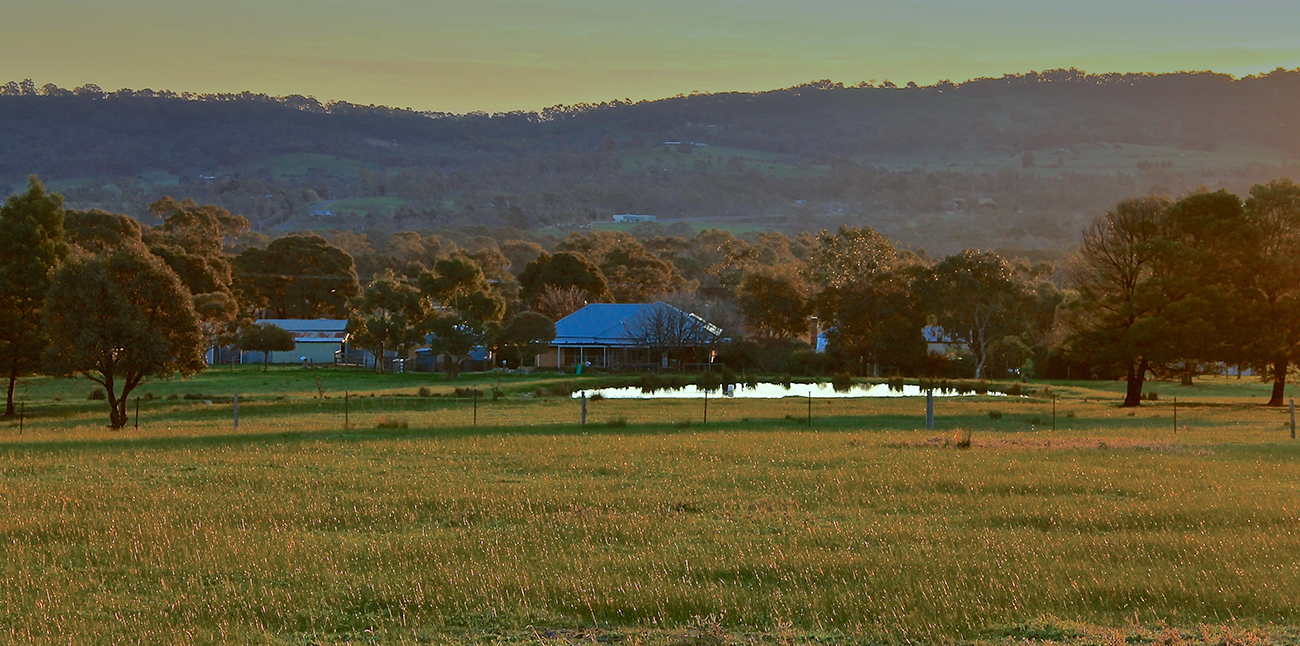
Many landscapes in our region are leading examples of sustainable property management (photo by Jarrod Coote)
Digging those dung beetles
Posted on 21 July, 2020 by Ivan
The dung beetle is one of the natural world’s wonders and the role of this hard-working insect is rarely recognised. We occasionally see dung beetles moving copious amounts of dung when out in the field, but rarely have time to stop and ponder their importance in ecosystem function and soil productivity. Thankfully, there is an expert who has devoted his life to Dung Beetles – Dr Bernard Doube – who recently delivered a presentation on behalf of the North Central Catchment Management Authority.
Dr Doube works for Dung Beetle Solutions International and delivered the presentation to bring us up to date with dung beetle species, the history of introduction to Australia and the benefits to agriculture. This presentation was delivered in June 2020 with the support of Landcare Victoria and North Central Catchment Management Authority.
Dr Doube is an international expert on dung beetles, earthworms and the biological basis of soil health. He worked with CSIRO for 29 years and was in charge of the CSIRO Dung Beetle Research Unit in Pretoria, South Africa, for seven years. He has published many research articles on dung beetles, earthworms and the biological basis of soil health. He has conducted grant-funded research since 2003 in association with many research partners, including water authorities, federal agencies, universities, Landcare and other landholder groups.
Australia has more than 500 species of native dung beetles and 23 species introduced from Hawaii, Africa and southern Europe. The introduced dung beetles are useful in Australia’s agricultural regions because our native dung beetles evolved with marsupials and are not adapted to use and disperse cattle dung.
Sometimes referred to as ‘nature’s architects’, dung beetles are part of a healthy agricultural landscape and can significantly improve the overall health of your soil. They benefit your property by breaking down organic material, transporting nutrients from the surface to the subsoil, improving water infiltration and reducing runoff.
It has also been concluded that dung beetles also reduce flies and odours by physically removing dung from the soil surface. This also helps to control dung-borne parasites. To learn more about dung beetles – click here
Please enjoy the presentation below, delivered by Dr Doube.
Understanding and restoring your land
Posted on 16 July, 2020 by Ivan
Connecting Country has been operating for over a decade now, and we don’t often have the time to reflect on what we’ve achieved and how we’ve assisted landholders and the community across the Mount Alexander region. We once had a large works crew, but now operate under a more nimble and streamlined model. We are still working hard to monitor our ecological assets, support Landcare, engage through education, and restore the landscape. Our work is often directed by our funding success, but we always aim to provide the latest information landowners and community members need to build their capacity to restore and manage land sustainably.
We often have funding available to assist landholders and other community members with their landscape restoration efforts. Unfortunately we don’t have such funding at present, due to funding cycles and a current lack of grants for environmental projects. However, we do have a wonderful Landscape Restoration Coordinator, Bonnie Humphreys, who is able to answer questions and enquiries from landowners about where to start with landscape restoration. Feel free to contact us via email (info@connectingcountrycountry.org.au) or phone (03 5472 1594) if you have any questions regarding where to start with landscape restoration or how to plan works on your property.

Connecting Country has restored 10,000 hectares of land in our region, which equates to around 6% of the Mount Alexander Shire (photo: Connecting Country)
Thankfully, we also have a brilliant website, with loads of information on understanding your landscape, soils, history and vegetation classification. Before starting any works on your property it is important to have a good understanding of your landscape.
Mapping
Obtaining some good aerial maps and property overlays is a key starting point. Mapping programs are available to help in identifying your soil types, land use, forest cover, vegetation classification and topography. These include:
- imap (North Central Catchment Management Authority)
- Mapshare (Department of Environment, Land, Water and Planning)
- Google mapsPreview (opens in a new tab)
Connecting Country website resources
The following links provide resources to help you better understand your property:
Equipment
If you are interested in conducting some flora and fauna monitoring on your property, we can provide some equipment and information guides to assist. Connecting Country has the following equipment that can be borrowed by Landcare groups and other members for flora and fauna monitoring:
- Garmin Etrex 10 hand held GPS units – 7 available
- Motion- sensitive/infrared wildlife cameras (incl. camera, instructions, memory card and batteries) – 8 available
- Bushnell binoculars suitable for birdwatching – 6 available
- The Slater & Gordon Field Guide to Australian Birds – 6 available
- Soil pH test kit – 3 available
- Indigenous Plants of Castlemaine and Surrounds- multiple copies
- Local weed guides – multiple copies
To arrange pick please contact Jacqui via email (jacqui@connectingcountry.org.au) or phone (03 5472 1594).
Getting that frog call checked by experts
Posted on 16 July, 2020 by Frances
All creatures great and small are celebrating the return of water in the landscape this autumn and winter 2020, with some healthy rainfall recorded across the Mount Alexander region in recent months. You may have heard an abundance of frog calls. Even here in the Connecting Country office at the Hub in central Castlemaine VIC, we’ve heard frogs in the adjoining community garden. One of the blessings of living in a healthy landscape is hearing the chorus of frog banter and the sounds of abundance.
We received a timely reminder from our local frog expert Elaine Bayes, of the importance of using the brilliant FrogID App for assisting with the identification of tricky frog calls of our region. FrogID is Australia’s first national citizen science frog identification initiative – a project led by the Australian Museum in partnership with Australia’s leading natural history museums and IBM. Anyone can use the App to create a profile, record frog calls and match your calls to the frog calls on the app, then upload your records to the Australian Museum frog experts for species verification.
One of the reasons to use the FrogID app is to ensure that all frog records are verified prior to entering records into the Atlas of Living Australia (ALA), the largest database of flora and fauna records in Australia. Records entered directly in the ALA are not verified, and it was recently discovered that there were some incorrect records of frog species entered in the Mount Alexander region. The ALA contains a number of sightings in our area of Striped Marsh Frog, which was previously rare in this region. However, upon closer assessment by frog experts, they suspect the frog recordings are actually the Spotted Marsh Frog (Limnodynastes tasmaniensis), not the Striped Marsh Frog (Limndoynastes peroni). The two calls are similar and easily confused.
This is an important case study of how incorrect identification can potentially affect distribution datasets. This is not the case with the Victorian Biodiversity Atlas, as every record submitted by users is verified for possible errors or mistaken identification.
The frog recordings submitted via the FrogID app are often verified in less than 24 hours, and it is a great resource to improve your skills and learn a lot more about frogs along the journey.
In just one year, FrogID has generated the equivalent of 13% of all frog records collected in Australia over the last 240 years – an amazing effort! The submitted recordings have resulted in over 66,000 validated calls and detected 175 of Australia’s 240 known native frogs.
The data has provided information about:
- Impacts of climate change and pollution on Australia’s frogs including the first evidence of the decline in Sydney of the Australian Green Tree Frog.
- Spread of the invasive Cane Toad.
- Breeding populations of 28 globally threatened and 13 nationally threatened frog species.
To download the FrogID App – click here
Location of all frog records for the first year of FrogID in Australia (image: ALA)
Landcare group health survey: closes 26 July 2020
Posted on 16 July, 2020 by Ivan
We received a request from the Department of Environment, Land, Water and Planning (DELWP) to assist them with an important survey for Landcare groups and members in our region. The survey will give them valuable information to make strategic funding decisions and allocations over the next year, and allow groups and members to provide feedback on their projects, memberships and volunteering activities. Please read on for details of the survey and how to complete it.
The Victorian Landcare Program 2019-20 Group Health Survey is now open and DELWP would love to hear what you have been doing, how you are going and your priorities for the next 12 months. The Group Health Survey provides a snapshot of the health of groups and the contribution of Landcare and environmental volunteering to a healthy environment.
Data collected through the Group Health Surveys is important to help DELWP and the Catchment Management Authorities understand the health of Landcare in Victoria and assists with planning the support provided through the Victorian Landcare Program.
To complete the survey – click here
Please complete by Sunday 26 July 2020. The survey should take about 30 minutes to complete. You may want to complete it at the next meeting of your group or share it between group members to complete different sections.
What’s in that nest box? – an update on our monitoring program
Posted on 9 July, 2020 by Jess
Connecting Country’s ten years of nest box monitoring
One way that Connecting Country contributes to nature conservation in the Mount Alexander region is through our nest box monitoring program. We set up this program in 2010 to monitor our favorite hollow-dependent marsupial: the Brush-tailed Phascogale. This adorable little animal has experienced a serious range contraction and decline in numbers across Victoria. However, the Mount Alexander region remains a stronghold for this special critter.
Our 450 nest boxes across the region help us to provide homes where natural nesting hollows are rare. They also allow us to monitor this species population through time and learn more about its habitat requirements, and provide a great opportunity for landholders and volunteers to engage with a rarely-seen animal and learn more about wildlife on their properties. This project has also contributed valuable information to the Victorian Biodiversity Atlas, an Arthur Rylah Institute investigation into nest box use in Victoria, and a PhD project at La Trobe University.
Life in a sharehouse
Our nest boxes are designed for phascogales, but they are also used by sugar gliders. The two species and their nests are easy to tell apart if you can get a really good look at them. Phascogales have a characteristic black brushy tail. They make messy, smelly nests with shredded bark, leaves, feathers, and fur, and leave scats in the nest. Sugar gliders have a rounder muzzle, a gliding membrane, a tapered grey and black tail (often with a white tip), and extra-cute big round eyes. They make neat nests of fresh eucalyptus leaves in a cup shape. Below, we have two phascogales in typical phascogale nests, and two sugar gliders in typical sugar glider nests.
To learn as much as we can about who’s been using a nest box, it’s important to take a really careful look and document what we see. It’s not always simple! Below, we have a sugar glider in a phascogale nest (left), and a phascogale in a sugar glider nest (right).
Checking nest boxes
Our nest boxes are usually installed on trees that don’t already have natural hollows, on tree species that have rough bark (so it’s easier for animals to climb to access the nest box), and face south-south-east so the boxes don’t get too hot in summer. They are usually installed about 3 m high above the ground to help keep our precious native animals safe from predators such as foxes, and keep our nest boxes safe from vandalism.
This brush-tailed phascogale was climbing a grey box tree to get to its Connecting Country nest box. Photo: Jess Lawton (La Trobe University)
However, this also presents some logistical and safety challenges. We’ve always checked out nest boxes by climbing a ladder and carefully opening the lid of the nest box to inspect and photograph contents (without flash). Climbing a ladder brings a safety risk, and we are always looking for ways to make things safer for our staff and volunteers.
Over the last two years we’ve been reviewing our monitoring program as part of our Habitat Health Check project, supported by Helen Macpherson Smith Trust. We’ve done this to ensure our program is robust, and our volunteers are trained and safe. As part of this process we decided to trial a new way of inspecting nest boxes, checking them from the ground using a nest box inspection camera – an endoscope-type camera on the end of a long pole. We wanted to find out if the inspection camera made nest box checks safer and more efficient. We also wanted to test if we got the same results during our nest box checks if we used this new inspection method.
A new way forward?
So, in early 2020, armed with the best nest box inspection camera we could get our hands on, we trialed both survey methods. Asha, Jess, and intrepid volunteers Alex and Trevor, checked 17 nest boxes across two properties in Sutton Grange with both survey methods: an inspection camera, and by climbing a ladder and carefully peeking inside. We divided into two teams and went our separate ways to check the nest boxes, so no-one could guess what was in a nest box by looking at the other team’s excited facial expressions!
Below, you can see what each team saw at three nest boxes with both inspection methods. The inspection camera on the left, and by climbing a ladder and peeking inside on the right.
Can you guess which nest box inspection method we prefer? The two teams got different results at 5 out of the 17 nest boxes we inspected (that’s 29% of nest boxes!). For one nest box, this was because of different understandings of what the different species nest’s look like, which highlights the need for comprehensive training for all our inspectors. However, the remaining differences in nest box results between the two methods were because it was difficult to get a good enough look inside the nest boxes with an inspection camera. Overall, the ladder inspection method gave us a more accurate picture of what was going on in the nest boxes.
We also learnt that using an inspection camera for our particular type of nest boxes was not necessarily faster because the nest box lids were tricky to open using a pole from the ground. Surprisingly, inspecting nest boxes by climbing a ladder seemed less disruptive to the animals, as it was faster and quieter to open the nest box lid from a ladder.
We don’t want to change monitoring method if this will make our results less accurate. If we change our ability to detect animals, we can’t tell if changes in recorded animals are because of real population changes, or because of a change in our monitoring method. Instead, our plan for the future is to improve our ladder safety procedures, equipment and training for our nest box inspectors. The inspection cameras will still be valuable as a community engagement tool and backup method.
We will closely monitor COVID-19 restrictions with the hope of monitoring our nest boxes again in Autumn 2021. We think seeing a wild phascogale in a nest box is a very special experience. Please contact Jess Lawton if you would like to be added to our volunteer list (jess@connectingcountry.org.au). Volunteers must have a reasonable level of fitness and be comfortable working in the bush. We will need some volunteers to climb ladders (training provided), and some volunteers to carry equipment and take notes with feet planted firmly on the ground.
Connecting Country wishes to acknowledge the invaluable current and past support for our nest box program provided by Helen Macpherson Smith Trust, Wettenhall Environment Trust and Bank Australia.
Hunting for fungi on Mount Alexander
Posted on 9 July, 2020 by Frances
Mushroom foragers will know that 2020 has been an exceptionally bountiful year for fungi in central Victoria. Recent rains have promoted an amazing flush of fruiting fungi to appear across our native woodlands, plantations and gardens.
We came across this beautifully recorded informative video about a recent trip to hunt for fungi on Mount Alexander, made by Liz Martin with Joy Clusker. Joy Clusker is the co-author of the wonderful book ‘Fungi of the Bendigo Region’ (2018). Joy and Liz have been going to check for fungi and to see if there is anything new for an updated book. Mount Alexander is a favourite spot and they recorded this trip in July 2020.
Make your fencing wildlife friendly
Posted on 8 July, 2020 by Frances
Many of us have had the awful experience of finding a wild animal tangled in a fence. Here is an excellent article from our friends at Newham & District Landcare Group, who do outstanding landscape restoration work in the Macedon Ranges region of Victoria. This article was written by Penny Roberts for the Newham & District Landcare Group news.
Make your fencing wildlife friendly
In Australia, barbed wire is so ubiquitous that most people are hardly aware of its presence.
It forms the boundaries of countless properties, estimated at tens of millions of kilometres, and is the accepted way of keeping sheep and cattle within those boundaries. More than 60% of this fencing has barb wire as the top strand.
However, it is a major hazard to our wildlife, with thousands of native animals becoming entangled on its barbs each year. Nobody really knows the extent or how many, as many are removed by the landholder or eaten by foxes, cats and even birds of prey.
One of our members recently spotted this Sugar Glider caught on barbed wire on a fence. Fortunately, with four hands available, the Glider was safely released and inspection showed it had suffered minimal damage to its membrane.
More than 80% of recorded wildlife entanglement occurs on the top strand of barbed wire fences. We often see kangaroos hung up on wire and mesh fences, legs caught in a twist of wire – a reflection of their numbers in our landscape at present – but more than 70 wildlife species have been identified in Australia as occasional or regular victims of barbed wire fences.
Nocturnal animals are at greatest risk, failing to see fencing or cannot clear the height in windy conditions – Bats, Gliders and Owls most commonly. It may be that the fence is over a food tree or the gliding distance between trees is too great.
Fences close to wetlands may result in insufficient clearance for take-off and landing safely.
Any barb wire presents a risk, however higher risks exist where fences are:
- Newly constructed
- On ridgelines.
- Crossing or surrounding waterways and dams.
- Near feed trees.
- Higher than surrounding vegetation.
Wildlife-friendly fencing:
- Remove any old fencing that has fallen into disrepair.
- Consider whether a fence is really necessary.
Although most property owners would be reluctant to change all of their barbed wire fencing to plain wire, there are some steps they can take to minimise the harm to our animals where fences are necessary:
- Identify the wildlife hotspots: along ridge lines, near feed trees, in wildlife corridors or over
waterways. - Run a strand of white electric fence tape above the barbed wire. This flickers in the wind and is
more visible than the grey wire. - Replace the top strand of barbed wire with plain wire or cover it with split polypipe.
- Attach old CDs which swivel and reflect the light to make hotspot sections of fence more visible.
Many thanks to Newham and District Landcare Group for sharing this useful information. To learn more about their group and read their news in full – click here
Some little known facts about platypus
Posted on 2 July, 2020 by Ivan
There is so much to love about one of our most unusual mammals, the platypus. They almost appear to be a blend of features from other creatures: notably a duck, a beaver and even a rakali. They are often misunderstood because we so rarely see these beautiful water creatures. Males are venomous, with sharp stingers on the heels of their rear feet that can deliver a toxic blow to any foe.

Based on mark-recapture studies along creeks in Victoria, a platypus home range typically measures 4-11 km (photo: Australian Platypus Conservancy)
The platypus is listed as ‘Near Threatened’ in Australia and on the International Union for Conservation of Nature Red List. For more information and maps of distribution – click here
The Friends of Campbells Creek Landcare Group’s incredible habitat restoration work along Campbells Creek here in central Victoria has improved local conditions for platypus. In late 2019 they worked with the Australian Platypus Conservancy to survey Campbells Creek for platypus and rakali, with results presented at a community workshop in March 2020. The survey identified a number of platypus in Campbells Creek, which was heartening, although results indicated there was not great potential for successful breeding and increase in distribution.
The Australian Platypus Conservancy recently worked with Holbrook Landcare to produce a short video about the platypus and its conservation needs. This video gives a terrific overview of the ecological requirements of this wonderful species and how we can restore our waterways to ensure populations grow into the future. Interestingly, the video notes that foxes are one of the worst predators for the platypus.
The video can be viewed via the image below or on YouTube – click here
For more information about Friends of Campbells Creek Landcare Group and the Platypus project – click here
For more information about the Australian Platypus Conservancy and their survey methods – click here
Mount Alexander Shire reviews local laws on invasive plants and animals
Posted on 2 July, 2020 by Ivan
We received an update from the Tarrangower Cactus Control Group with some exciting developments on the persistent problems of invasive plants and animals in the Mount Alexander region of central Victoria. Many of our readers will be familiar with the frustrations of trying to manage invasive species on a local scale, only to find the issues keep persisting due to a lack of control elsewhere in the landscape.
To access Connecting Country’s fact sheet aimed at assisting landowners to manage invasive plants and animals – click here
Tarrangower Cactus Control Group asked us to post the following update about the recent review of local laws by Mount Alexander Shire Council.
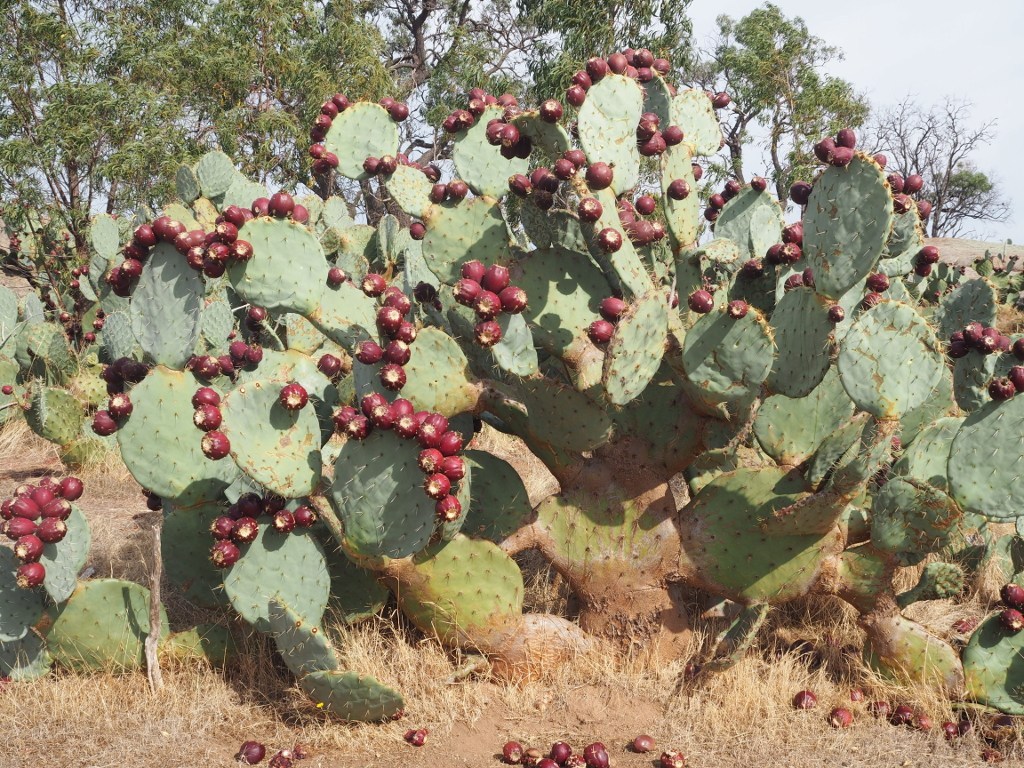
A large fruiting wheel cactus plant, one of the most destructive invasive species in our region (photo: Tarrangower Cactus Control Group)
Review and draft proposal of Mount Alexander Shire local laws
Over the past couple of years, a review of the Mount Alexander Shire Council’s (MASC) Local Laws has been carried out. During this review process, the Tarrangower Cactus Control Group (TCCG) took the opportunity to express their concerns to MASC of how ineffective and ambiguous the existing law is concerning noxious weed control. TCCG members met with Shire staff and requested greater clarity and priority be given to noxious weed management in the future Local Laws.
The outcome of these discussions has resulted in the creation of a new, specific clause for ‘Control of noxious weeds’ (Clause 19). In the current Local Law (2010) the only mention of noxious weeds is buried, insignificantly, in Local Law No. 3 ‘Environment’, under Clause 12 ‘Dangerous or unsightly land’, in a sub-clause (12.1(f)).
In the new proposed Local Law (2020), Clause 12 has been expanded into three new clauses (17, 18 and 19) to give much greater definition, clarity and interpretation to the environmental issues previously concealed in one clause.
The new, specific Clause 19 ‘Control of noxious weeds’ includes a definition of ‘noxious weeds’ and reference to the Catchment and Land Protection Act 1994 and the Catchment and Land Protection Regulations 2012. In addition, the penalty has been doubled, from 5 to 10 penalty points.
These changes will hopefully raise the status and significance of noxious weed control in our Shire and reduce the ambiguity that the previous sub-clause created. The new clause will provide the Shire’s Bylaw Officers with a clearer definition of noxious weed management and hopefully result in increased enforcement action with non-compliant property owners.
This new, specific ‘noxious weed’ clause should also be more effective by making it easier for landowners to seek help from MASC Bylaw Officers to enforce weed control action by neighbours, especially absentee owners.
The draft proposed version of the Local Laws is now completed and has been published for community comments. Please take a look at the new version of the Local Law and send in some positive feedback to MASC in support of the amendments. Feedback needs to be submitted before end of July when Council will vote to accept the new version. Log onto the MASC website and go to their ‘Have your say’ page to find the document and link for feedback.
Tarrangower Cactus Control Group
Cats and dogs in public places: survey
Posted on 1 July, 2020 by Ivan
Mount Alexander Shire Council is currently asking the community to complete a survey on a proposed Order of Council for the Control of Dogs and Cats in public spaces. We have been asked to assist with distributing the survey to our audience, so they can get the best data on what the community wants from this proposal. The council aims to develop sensible controls for how dogs and cats are managed within our Shire, under a new Order of Council.
The proposed Order of Council will provide dog and cat owners with a clear understanding of when their pet needs to be placed under effective control. It will also consider the differences between urban and rural parts of the Shire by allowing for variations in less densely populated areas. Following a strong push from the community, a number of local councils are also introducing cat curfews and other initiatives to limit prowling and reduce the number of native animals they kill.
The ABC recently published a news article that summarised research on the shocking impact of feral and pet cats killing billions of animals each year.
Mount Alexander Shire Council provided the following information about the survey.

Cats can be a man’s best friend, but also a wildlife disaster if let to roam free (photo: Brisbane City Council)
Why is Council doing this now?
Experience tells us that the community’s general expectation is that there should be some restrictions placed on dog owners in how they allow their pets to interact with other members of the public. Following a strong push from the community, a number of Councils are also introducing cat curfews and other initiatives to limit prowling and reduce the number of native animals and birds they kill.
Within the community there are those who like dogs and those who do not. Similar feelings apply to cats. Council’s responsibility is to develop laws that balance community views and do not unreasonably favour or disadvantage an individual or group.
The proposed Order of Council would support Council’s broader objective of increasing responsible pet ownership by taking a proactive approach to the task of controlling dogs and cats in public places. What these controls look like, and how they operate, will be informed by community feedback.
Council is currently undertaking a review of the control of dogs and cats in a public place and has developed a survey to help review this process.
Next steps
Council will review all submissions from community members and use the feedback to inform a new Order of Council. The new Order will be presented to Council for consideration at a public meeting later in 2020.
If the Order is adopted by Council, it will become effective once it is published in the Government Gazette and locally circulating newspaper. When that occurs, Council will also undertake a community-wide education process to ensure our residents and visitors are familiar with the new regulations relating to dogs and cats in public places.
If you’d like any further information about this process; if you need assistance to complete the survey; or if you’d like more information on how an Order of Council would work, please contact Mr Jeffry Amy, Coordinator Community Safety and Amenity, on 5471 1700.
Please click here to complete the survey.
We would greatly appreciate your feedback and please feel free to distribute this to any colleagues or members so that they can have a chance to develop controls which best suit our community. There are no trick questions or wrong answers just select any of the options that you think should be included. All Mount Alexander Shire residents are encouraged to have their say. I have attached an electronic copy should anyone prefer this over the survey.
Regards
Jeffry Amy | Coordinator Community Safety and Amenity | Mount Alexander Shire Council
t (03) 5471 1764 | m 0429 599 249 | www.mountalexander.vic.gov.au
Civic Centre | Corner Lyttleton and Lloyd Streets | PO Box 185 | Castlemaine Victoria 3450




